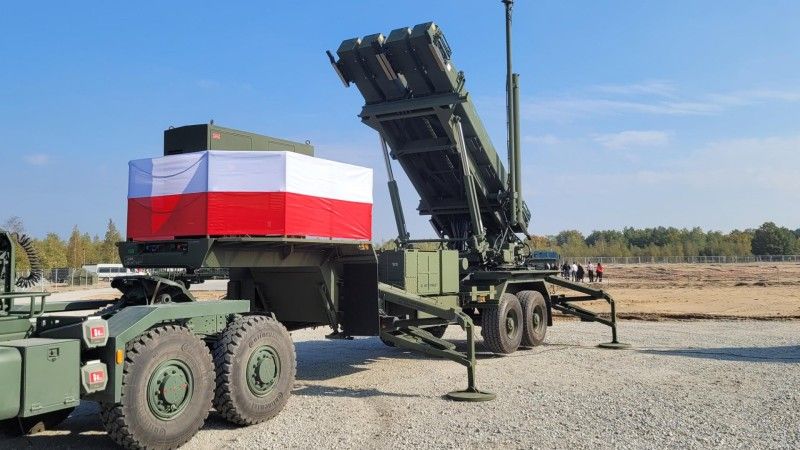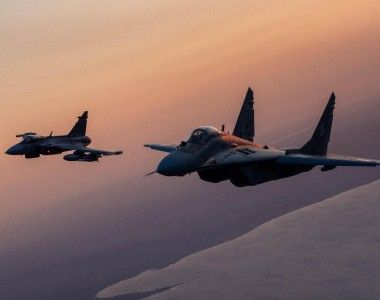Polish Air Defence Enters a New Era [COMMENTARY]

The integration of the Patriot system is just one of many elements in the process of establishing the Polish IADS. Recently the Polish Armed Forces acquired the first „Little Narew” multi-channel air defence system, and a framework agreement has been signed regarding the Pilica+ system. Yet, the most serious challenges are still to be faced by the Armed Forces, the industry, and the Polish Ministry of Defence.
The medium range is covered by the Patriot system, below one may find the Narew system, while all of that is complemented with the Pilica SAM, said the head of the Polish Ministry of Defence, Mariusz Błaszczak.
The integration is to be divided into stages, while the individual elements would undergo integration at the 37th Air Defence Missile Squadron based in Sochaczew (IBCS), and then, again, in Toruń. The finalization of integration and training at the 37th Squadron would mean that the first SAM unit of the Air Force would gain medium-range (100 kilometres, depending on the target) capabilities, and missile defence capability would also become available. This would be a milestone in the modernization of the Polish IADS.

Photo. Maciej Szopa/Defence24.pl
Let us add that the Polish Armed Forces, specifically the newly formed 18th Air Defence Regiment, has recently received the first "Little Narew" fire unit, making it possible to engage multiple threats at once, with the use of the CAMM missiles, and Zenit fire control system integrated with the Polish Soła radar. This is a milestone. Both "Little Narew", as well as the Patriot system are the first SAM systems with ranges exceeding 7 kilometres, commissioned in the Polish military since 3 decades.

Photo. Maciej Szopa/Defence24.pl
Up until recently, apart from the Piorun/Grom MANPADS, and combined AAA/SAM systems using these reputable missiles (such as Pilica), the Polish Armed Forces have only been using upgraded Post-Soviet air defence assets. There's no doubt, these should be replaced, as they do not meet the requirements of the contemporary battlespace. Kub and Newa-SC SAM systems belong to the generation that preceded the Buk and S300 SAMs that Ukraine is using in its air defence efforts. Some of the lighter Osa-P systems have probably been handed off to Ukraine, as this is indicated by a release issued by General Valeriy Zaluzhny, the Chief Commander of the Armed Forces of Ukraine. The release states that Osa systems may have been used to shoot down 9 Shahed UAVs.
Read more
The Polish Armed Forces are undoubtedly entering a new era, of modern air defences. The Polish IADS would use both foreign systems, such as the Patriot missiles, or the IBCS system bringing all air defence assets together. The IBCS would be tailored to the Polish requirements and created with a major part being played by the Polish industry. Domestic systems would also be used, such as radars (apart from the LTAMDS), or elements of the C2 network. The international cooperation would also pertain to the effectors - missiles. The first lots of the CAMM missiles have already been delivered from the UK. Meanwhile, the CAMM-ER missiles, with a range of 45 kilometres, and expected to be used in the Narew system are going to be license-manufactured. The new CAMM-MR missile, with an even greater range, is to be jointly developed by the Polish and British industries, filling the gaps in the Polish IADS. The industrial, cooperative effort also pertains to some elements of the PAC-3 MSE missiles and LTAMDS radars.
The first "Little Narew", or Patriot deliveries are an important training opportunity, also making it possible to gain experience and define the procedures. The Polish Armed Forces should receive much more air defence systems in the coming years. And this would be a challenge from a financial perspective. But that would not be such a problem during a full-scale war in the east - still, there is the life cycle management question floating around. Furthermore, the establishment of infrastructure and training of the personnel may also be challenging. Paradoxically, the latter may be difficult, as delivery of more equipment renders requirements different from that in which minor quantities are commissioned.
One should only hope that the first training experiences would make it possible to develop an effective training system. And one should also feed properly prepared troops into that training system. The reserves would not be readily available, as it happens in the case of legacy air defence solutions. In parallel, the numbers would grow also in other areas in the Polish Armed Forces - for instance in the artillery component, not to mention other new units. Human resources preparation may be a relevant challenge here.
Furthermore, there are numerous modernization programmes already underway, requiring relevant preparation and funding.
Air Defence Modernization Implementation:
1. Piorun MANPADS
Piorun is the first air defence modernization program underway now. It is a new generation MANPADS that has been delivered continuously by Mesko since 2018 now. This year it was also ordered by the United States (before the full-scale war started in Ukraine), and by Estonia. Ukraine has received some Piorun systems as a part of the military aid package. They have seen quite successful combat use. In June this year, an annex to the Polish Piorun procurement contract has been signed, significantly expanding the scope of deliveries. Originally, back in 2016, the assumption was that 420 launch mechanisms and 1,300 missiles would be ordered. The new agreement envisages the procurement of extra 3,500 missiles and 600 launch systems. The expanded scope of Piorun procurement would result in a very strong reinforcement of the Polish VSHORAD capability. It is expected that Piorun would be further developed. The system is simple to use and highly rated by the soldiers. One could risk a statement that increasing the number of the Piorun systems at hand is relatively the easiest of the planned undertakings, given the specific nature of these assets. Nonetheless, this does not mean that this acquisition is the least important one.

Photo. Jarosław Ciślak/defence24.pl
2. Pilica+
In early October, a framework agreement was signed on the procurement of 21 Pilica+ fire units, in parallel to the "Little Narew" acquisition. This exemplifies the expansion of capabilities based on the domestic potential, as the Pilica system, which was originally to use solely 23 mm AAA assets, and Grom/Piorun launchers, would now feature a whole new set of capabilities. New Polish Bystra radars and CAMM launchers would also be integrated with this system. In the longer run, air-burst programmable ammunition and a counter-UAS solution would be added to Pilica+'s list of capabilities as well. The primary function of this system would be to protect the Wisła MRAD assets on the move and to act in the VSHORAD role.
The Pilica/Pilica+ system's architecture is quite compact these days. It would hence be highly mobile and capable of protecting the quite expansive Patriot batteries, for instance from anti-radiation missiles, PGMs, and so on. But getting properly trained personnel for the Pilica+ system would also be required, in high numbers, as the original plan assumed 6 fire units would be procured. Ultimately, it was decided that 21 FUs are going to be acquired instead.
Read more
3. Narew
Narew SHORAD programme is the most convoluted of the Polish air defence undertakings. Its quantitative scope is large already, and further expansion is also expected. 19 batteries/38 fire units were to be procured for the Polish Armed Forces with its 3 divisions. This included 114 launchers, 8 missiles each. The current agreement assumes 23 fire units would be acquired, but it had been signed before the plan to form two new divisions was announced (with an assumption of a 4-divisions overall structure). In 2022 it was decided that a gap-filler capacity should be put into place, dubbed "Little Narew" ("Mała Narew"), providing the baseline potential, when it comes to multi-channel systems capable of engaging multiple threats at once.

Photo. Polish MoD
But the "big" Narew system is far more ambitious. Here, we are considering procurement of fire units armed with license-manufactured CAMM-ER (by default), and CAMM-MR (in the future) missiles, and supported by multifunctional Sajna fire control radars developed by PIT-RADWAR specifically for Narew, along with PET-PCL and P-18PL early warning radars. All of those elements are to be connected with the Wisła system via the IBCS network, in a configuration tailored to the Polish requirements. The Polish industry is also expected to play a major part in the delivery of the C2 system elements. The consortium led by the PGZ Group is also the leader of the Narew programme. It is very ambitious and extremely important. Narew is to be tasked with neutralizing most of the air-breathing targets, such as fixed- and rotary-wing aircraft. The IBCS would allow Narew to work in sync with Wisła, and other networked elements, such as the F-35 MRCA, acting as sensors within the whole IADS network.
4. Wisła - Phase II
And finally, the Wisła MRAD system programme is going to be continued. On 24th May, during his opening speech at the Defence24 DAY conference, Mariusz Błaszczak announced that an LoR has been submitted, regarding the Phase II of the Wisła programme. That phase would include six Patriot/IBCS batteries with PAC-3 MSE missiles and LTAMDS radars, providing 360-degree coverage. The preliminary timeline announced by the Armament Agency assumed that the above assets would be delivered between 2026 and 2028. After that process is completed, Poland would have 16 Patriot/IBCS Fire Units, supported by Pilica+, and the Narew system tied directly to Wisła and expected to be gradually expanded. Altogether, those assets would create a very strong, layered air defence system.
However, the accomplishment of all those tasks would be costly. In total, the air defence expenditure (counting the procurement phase alone) would probably exceed USD 20 billion. Here, one should also account for the major challenge tied to the training of the personnel, specifically, a new generation (or generations) of air defence specialists who would be able to put an entirely new set of modern equipment into use. And this would also be done in a situation when the HR status of the Armed Forces is far from perfect when it comes to trained specialists. There are numerous challenges ahead, as the list above is by no means an exhaustive one. Sona system for the protection of mobile land forces elements, or Nida counter-UAS solution are next on the list of plans, and they are also quite necessary.
But there is no other way here - the only sensible approach would involve the establishment of a modern, integrated, layered air defence system. This has been proven by the war in Ukraine, and one would need to remember that for decades. Modernization shall be planned and pursued in a way that would allow for the rapid acquisition of the necessary capabilities. On the other hand, the life cycle management of those should be properly handled, with further attention paid to other domains of the state defence system. That system is a complex one, just like IADS, and it should be approached comprehensively.





